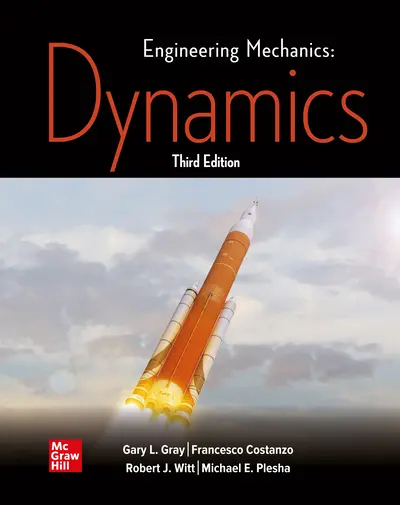My Account Details

ISBN10: 1264979746 | ISBN13: 9781264979745

Engineering Mechanics: Dynamics
Product not yet available for student view. Change to an older release to view student options.
Textbook Rental (150 Days Access)
- Rent for a fraction of the printed textbook price
- Complete text bound in hardcover or softcover
Loose-Leaf Purchase
- Unbound loose-leaf version of full text
- Discount loose-leaf available within Connect
Shipping Options
- Standard
- Next-day air
- 2nd-day air
Orders within the United States are shipped via FedEx or UPS Ground. For shipments to locations outside of the U.S., only standard shipping is available. All shipping options assume the product is available and that processing an order takes 24 to 48 hours prior to shipping.
Textbook Rental (150 Days Access)
Details:
- Rentable option
- Hardcopy and softcover formats
Loose-Leaf Purchase
Details:
- Unbound loose-leaf version of full text
* The estimated amount of time this product will be on the market is based on a number of factors, including faculty input to instructional design and the prior revision cycle and updates to academic research-which typically results in a revision cycle ranging from every two to four years for this product. Pricing subject to change at any time.
About the Author
Gary Gray
Gary L. Gray is an Associate Professor of Engineering Science and Mechanics in the Department of Engineering Science and Mechanics at Penn State in University Park, PA. He received a B.S. in Mechanical Engineering (cum laude) from Washington University in St. Louis, MO, an S.M. in Engineering Science from Harvard University, and M.S. and Ph.D. degrees in Engineering Mechanics from the University of Wisconsin-Madison. His primary research interests are in dynamical systems, dynamics of mechanical systems, mechanics education, and multi-scale methods for predicting continuum-level properties of materials from molecular calculations. For his contributions to mechanics education, he has been awarded the Outstanding and Premier Teaching Awards from the Penn State Engineering Society, the Outstanding New Mechanics Educator Award from the American Society for Engineering Education, the Learning Excellence Award from General Electric, and the Collaborative and Curricular Innovations Special Recognition Award from the Provost of Penn State. In addition to dynamics, he also teaches mechanics of materials, mechanical vibrations, numerical methods, advanced dynamics, and engineering mathematics.
Francesco Costanzo
Francesco Costanzo is an Associate Professor of Engineering Science and Mechanics in the Engineering Science and Mechanics Department at Penn State. He received the Laurea in Ingegneria Aeronautica from the Politecnico di Milano, Milan, Italy. After coming to the U.S. as a Fulbright scholar he received his Ph.D. in aerospace engineering from Texas A&M University. His primary research interest is the mathematical and numerical modeling of material behavior. He has focused on the theoretical and numerical characterization of dynamic fracture in materials subject to thermo-mechanical loading via the use of cohesive zone models and various fi nite element methods, including space-time formulations. His research has also focused on the development of multi-scale methods for predicting continuum-level material properties from molecular calculations, including the development of molecular dynamics methods for the determination of the stress-strain response of nonlinear elastic systems. In addition to scientifi c research, he has contributed to various projects for the advancement of mechanics education under the sponsorship of several organizations, including the National Science Foundation. For his contributions, he has received various awards, including the 1998 and the 2003 GE Learning Excellence Awards, and the 1999 ASEE Outstanding New Mechanics Educator Award. In addition to teaching dynamics, he also teaches statics, mechanics of materials, continuum mechanics, and mathematical theory of elasticity.
Robert J. Witt
Robert J. Witt retired from the University of Wisconsin–Madison, Department of Engineering Physics, in 2020 after a 33-year teaching career. He received his B.S. in mechanical engineering from the University of California–Davis and his M.S. and Ph.D. in nuclear engineering from MIT. His research interests were in computational methods in fluid and solid mechanics, with particular applications to nuclear systems. He taught 20 different courses over the span of his career, including statics, dynamics, mechanics of materials, and a variety of other classes in applied mechanics, computational methods, and nuclear engineering. He is coauthor of the book Concepts and Applications of Finite Element Analysis (with R. D. Cook, D. S. Malkus, and M. E. Plesha).
Michael Plesha
Michael E. Plesha is a Professor of Engineering Mechanics in the Department of Engineering Physics at the University of Wisconsin-Madison. Professor Plesha received his B.S. from the University of Illinois-Chicago in structural engineering and materials, and his M.S. and Ph.D. from Northwestern University in structural engineering and applied mechanics. His primary research areas are computational mechanics, focusing on the development of fi nite element and discrete element methods for solving static and dynamic nonlinear problems, and the development of constitutive models for characterizing behavior of materials. Much of his work focuses on problems featuring contact, friction, and material interfaces. Applications include nanotribology, high temperature rheology of ceramic composite materials, modeling geomaterials including rock and soil, penetration mechanics, and modeling crack growth in structures. He is co-author of the book Concepts and Applications of Finite Element Analysis (with R. D. Cook, D. S. Malkus, and R. J. Witt). He teaches courses in statics, basic and advanced mechanics of materials, mechanical vibrations, and fi nite element methods.
Need support? We're here to help - Get real-world support and resources every step of the way.
